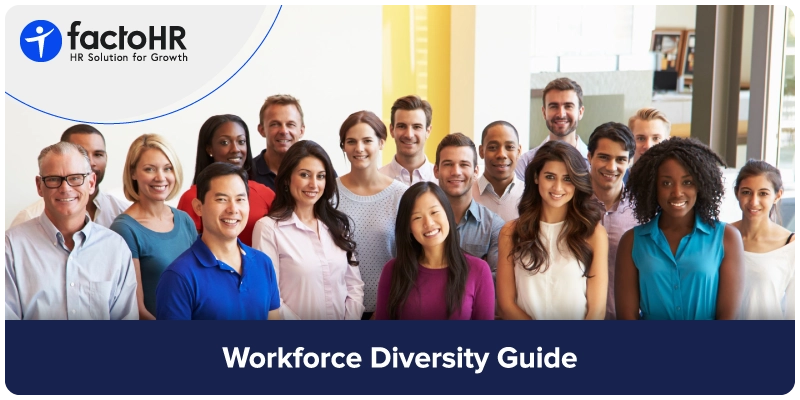What Is Workforce Diversity? | Meaning, Importance, and Types

Table of Contents
In recent years, diversity in the workforce has garnered significant attention within companies. While some find it fruitful for their business endeavors, others still doubt its success. Here is an interesting Fact about Workforce Diversity:
According to a recent report by CNBC, around 80% of employees prefer to work for a company that promotes diversity, equity, and inclusion in its workforce.
Clearly, diversity seems to be pivotal in shaping a company’s success. Let’s delve deeper into Workforce diversity, its importance, its types, and how companies can use this information.
What Is Workforce Diversity?
Workforce Diversity refers to a team of employees from different cultures, backgrounds, sexes, ages, sexual orientations, religions, and genders working together in a company. It also includes personnel with different disabilities. Simply put, workforce diversity means a heterogeneous mix of personnel working together as a team.
The core function of the HR team is human resource management, but they are also responsible for diversity in the workforce.
Why Is Workforce Diversity Important?
Maintaining diversity in the workforce is crucial in today’s competitive era. It allows companies to enjoy some valuable advantages, some of which are mentioned below.
- Attracting top talent to their company.
- Retaining more employees with less personnel turnover
- Improving client satisfaction
- Enjoying a good reputation in the eyes of employees and clients.

5 Different Types of Workforce Diversity
Here are the five common types of diversity in the workforce explained in detail.
1. Age Diversity
Age Diversity in a workforce is essential because when people of different age groups work together, they share their values and perspectives with each other. While the junior/new workforce brings fresh ideas to the table, the senior members blend them with their expertise and experience to yield the best results.
2. Cultural Diversity
Culture encompasses a person’s beliefs, ethnic background, social values, and behavioral traits that one learns from the family. Having cultural diversity in the workforce can bring wonders to companies and businesses when they are working with clients from different countries. By being aware and respectful of different cultures, the team can serve the clients (who may belong to a different culture) better. It enables them to be sensitive to not just the clients’ culture but also their audience at large. The recent controversy around the now pulled-down Zomato advertisement shows why cultural diversity is so important in teams at all levels.
3. Racial Diversity
Racial diversity is often confused with cultural diversity. However, both are different. Race refers to biological identity and physical traits. Culture, on the other hand, brings together social and ethnic aspects. Racial diversity allows team members to encounter completely new ideologies.
4. Gender Diversity
Running a business or company with a gender-diverse workforce comes with several perks. By building respect for every gender identity, collaboration and communication among the team members become more efficient. This, in turn, improves their interactions with clients, strengthening the business relationships.
5. Disabilities
There are many types of disabilities, like physical, mental, etc. Running a diverse workforce on the disability front makes the working space more welcoming and comfortable to work. This builds a positive reputation for the brand in the eyes of your clients and workers while destigmatizing discrimination against disability.
Benefits of Opting for Diversity in the Workplace
1. High Creativity & Innovation
When people with different perspectives work on the same thing, they develop new ideas. A diverse team’s wide range of perspectives allows it to consider and integrate different viewpoints and challenge conventional ideas. The end result is out-of-the-box and innovative solutions.
2. Improved Decision Making
Working in a diverse team opens several new fronts for the team. They can combine their diverse knowledge to make better decisions for solving issues in less time. According to a study by People Management, business performance is improved with collaborative decision-making by the whole team.
3. Better Employee Engagement
Employee engagement is directly linked to a team’s inclusiveness. An employee who feels included engages well with the team and performs better.
In a diverse workforce, all team members feel included, which improves their communication and interpersonal relationships and further enhances their performance.
4. Solid Company Reputation & Less Employee Turnover
Companies working with diverse teams have a good reputation in the market. In today’s times, it is not just the employers who choose their employees. Talented employees also make a conscious choice of which employer brand they wish to work for. In such a scenario, companies have to work hard to be regarded as the employer of choice. Promoting diversity is one way to achieve that.
5. Higher Profits
With better decision-making ability, higher creativity, and a solid reputation, a company with a diverse workforce will quickly grab new opportunities and pave its way to the top with fat paychecks.

Chief Goal of Workforce Diversity
The prime goal of diversity in the workforce is to create a safe, comfortable, and respectful space for personnel from different age groups, sexual orientations, races, cultures, and disabilities. A space where they can work and collaborate together with respect and dignity that further enhances their capabilities as individuals and overall team.
Top Challenges in Workforce Diversity
There are certain risks or challenges associated with a diverse workforce. Let us have a look at them.
- Communication barrier—When differences are too obvious, and the teams have not gone through specific training, there are plenty of chances of reduced/lack of communication, if not miscommunication, amongst the team members.
- Higher conflict potential and misunderstandings based on ethnicity and race
- Increased training requirement—Organisations should invest in quality training specifically designed to educate employees on how to operate in an environment with a diverse group of individuals. This is in addition to other mandatory requirements like compliance training and job role-related skill development training.
- Higher chance of discrimination—When diverse people are brought together due to the company’s forward-looking strategy, there is an increased chance of discrimination initially.
Tips for Managing and Promoting Workforce Diversity Efficiently
Here are some tips for better management of a diverse workforce.
Standardized Criteria
It is critical to set base standards for all employees irrespective of their background, culture, gender, or other aspect. Make sure that all the actions and activities in your company follow standard base criteria for all your employees.
Better Communication
Train your management and communication team to communicate with all employees sensitively and empathetically. Conduct regular training to brief your employees on what is acceptable and what is not in today’s changing social scenario. Addressing people with their preferred pronouns (without being presumptuous) is just one of the many changes in communication that companies are adopting these days.
Respecting Every Individual
Ensure the managers and employees in leadership roles do not make assumptions about any team member. Every individual needs to be treated with respect and dignity irrespective of their race, background, or any other aspect.
Diverse Hiring
Hiring personnel for your team from different backgrounds, ages, sex, and races is important to create a diverse workforce. The hiring committee should focus on experience, skill set, and education without any bias while hiring the team members, which will help them select a diverse workforce naturally.
Top Examples of Diversity in the Workplace
Here are some examples of companies that maintain a diverse workspace:
- Johnson & Johnson got the first position for having a diverse and inclusive workforce in 2016.
- EY topped the DiversityInc Top 50 Companies for Diversity list in 2017.
- Clorox comes in the top three companies that provide the best place for diverse managers and women.
Conclusion
Diversity in the workforce is not just a fancy corporate term limited to presentation slides. It is about a complete shift in mindset driven by top management. The sooner companies realize its importance, the better their revenue and reputation will be.
Diversity in the workforce packs a punch beyond just filling quotas. It sparks a melting pot of ideas where innovation is the priority. Smart companies know this secret and that is what boosts their talent pool, cranks up creativity, and sharpens decision-making.
But wait, there’s more! Diverse teams get customers like no other. They speak their language and the result is loyal customers and a leg up on the competition. Additionally, when diversity becomes part of a company’s DNA, it polishes their image and pushes society forward. It’s a win-win – creating a place where everyone can shine and make their mark. factoHR understands the power of diversity and inclusion in driving business success. This comprehensive HRMS solution is designed to help you cultivate a diverse and thriving workforce.

Frequently Asked Questions
1. What Does Workforce Diversity Entail?
Diversity in the workforce includes age diversity, cultural diversity, racial diversity, gender diversity, and diversity related to disabilities. Each type brings unique perspectives and experiences to the workplace, creating a more dynamic and inclusive environment.
2. What Are the Advantages of Broader Diversity in the Workforce to Companies?
Companies can benefit from having a diverse pool of employees in the workforce. Some benefits include increased creativity and innovation, better decision-making, more productivity, a stronger reputation, reduced turnover, and greater financial success through business performance.
3. What Challenges Come With Managing a Diverse Workforce?
The obstacles of dealing with a diverse workforce incorporate language barriers, conflicts or reliance on ethnicity, substantial training obligations, and discrimination.
Effective communication, training, and inclusive policies have the potential to reduce or resolve these challenges on the whole if appropriately executed.
4. How Can Companies Promote and Manage Workforce Diversity Effectively?
Accomplishing standard measures for all staff, improving communication and sensitivity training, and practicing the principles of respect for everyone at every level are key to the promotion and effective management of diversity in the workforce.
Grow your business with factoHR today
Focus on the significant decision-making tasks, transfer all your common repetitive HR tasks to factoHR and see the things falling into their place.

© 2026 Copyright factoHR


